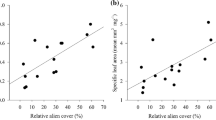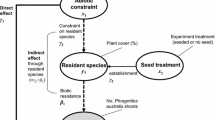Abstract
To improve the understanding of how native plant diversity influences invasion, we examined how population and community diversity may directly and indirectly be related to invasion in a natural field setting. Due to the large impact of the dominant C4 grass species (Andropogon gerardii) on invasion resistance of tallgrass prairie, we hypothesized that genetic diversity and associated traits within a population of this species would be more strongly related to invasion than diversity or traits of the rest of the community. We added seeds of the exotic invasive C4 grass, A. bladhii, to 1-m2 plots in intact tallgrass prairie that varied in genetic diversity of A. gerardii and plant community diversity, but not species richness. We assessed relationships among genetic diversity and traits of A. gerardii, community diversity, community aggregated traits, resource availability, and early season establishment and late-season persistence of the invader using structural equation modeling (SEM). SEM models suggested that community diversity likely enhanced invasion indirectly through increasing community aggregated specific leaf area as a consequence of more favorable microclimatic conditions for seedling establishment. In contrast, neither population nor community diversity was directly or indirectly related to late season survival of invasive seedlings. Our research suggests that while much of diversity–invasion research has separately focused on the direct effects of genetic and species diversity, when taken together, we find that the role of both levels of diversity on invasion resistance may be more complex, whereby effects of diversity may be primarily indirect via traits and vary depending on the stage of invasion.




Similar content being viewed by others
References
Aarssen LW (1983) Ecological combining ability and competitive combining ability in plants—toward a general evolutionary-theory of coexistence in systems of competition. Am Nat 122:707–731
Antonovics J (1992) Toward community genetics. In: Fritz RS, Simms EL (eds) Plant resistance to herbivores and pathogens. University of Chicago Press, Chicago, pp 426–449
Arrigo N, Tuszynski JW, Ehrich D, Gerdes T, Alvarez N (2009) Evaluating the impact of scoring parameters on the structure of intra-specific genetic variation using RawGeno, an R package for automating AFLP scoring. BMC Bioinformatics 10:1–14
Avolio ML, Chang CC, Smith MD (2011) Assessing fine-scale genotypic structure of a dominant species in native grasslands. Am Midl Nat 165:211–224
Benson EJ, Hartnett DC (2006) The role of seed and vegetative reproduction in plant recruitment and demography in tallgrass prairie. Plant Ecol 187:163–177
Booth RE, Grime JP (2003) Effects of genetic impoverishment on plant community diversity. J Ecol 91:721–730
Briggs JM, Knapp AK (2001) Determinants of C3 forb growth and production in a C4 dominated grassland. Plant Ecol 152:93–100
Bruno JF, Kennedy CW, Rand TA, Grant MB (2004) Landscape-scale patterns of biological invasions in shoreline plant communities. Oikos 107:531–540
Cheplick GP (1998) Population biology of grasses. Cambridge University Press, New York
Cook-Patton SC, McArt SH, Parachnowitsch AL, Thaler JS, Agrawal AA (2011) A direct comparison of the consequences of plant genotypic and species diversity on communities and ecosystem function. Ecology 92:915–923
Crutsinger GM, Collins MD, Fordyce JA, Gompert Z, Nice CC, Sanders NJ (2006) Plant genotypic diversity predicts community structure and governs an ecosystem process. Science 313:966–968
Crutsinger GM, Souza L, Sanders NJ (2008) Intraspecific diversity and dominant genotypes resist plant invasions. Ecol Lett 11:16–23
Diaz S, Cabido M (2001) Vive la difference: plant functional diversity matters to ecosystem processes. Trends Ecol Evol 16:646–655
Dukes JS (2002) Species composition and diversity affect grassland susceptibility and response to invasion. Ecol Appl 12:602–617
Ehlers A, Worm B, Reusch TBH (2008) Importance of genetic diversity in eelgrass Zostera marina for its resilience to global warming. Mar Ecol Prog Ser 355:1–7
Elton CS (2000) The ecology of invasions by animals and plants. University of Chicago Press, Chicago
Emery SM, Gross KL (2007) Dominant species identity, not community evenness, regulates invasion in experimental grassland plant communities. Ecology 88:954–964
Fridley JD, Brown RL, Bruno JE (2004) Null models of exotic invasion and scale-dependent patterns of native and exotic species richness. Ecology 85:3215–3222
Fridley JD, Grime JP, Bilton M (2007a) Genetic identity of interspecific neighbours mediates plant responses to competition and environmental variation in a species-rich grassland. J Ecol 95:908–915
Fridley JD et al (2007b) The invasion paradox: reconciling pattern and process in species invasions. Ecology 88:3–17
Garnier E et al (2004) Plant functional markers capture ecosystem properties during secondary succession. Ecology 85:2630–2637
Grace JB (2006) Structural equation modeling and natural systems. Cambridge University Press, Cambridge
Grime JP (2001) Plant strategies, vegetation processes, and ecosystem properties, 2nd edn. Wiley, Chichester
Harmoney KR, Hickman KR (2004) Comparative morphology of Caucasian old world bluestem and native grasses. Agron J 96:1540–1544
He TH, Lamont BB (2010) Species versus genotypic diversity of a nitrogen-fixing plant functional group in a metacommunity. Popul Ecol 52:337–345
Holland BR, Clarke AC, Meudt HM (2008) Optimizing automated AFLP scoring parameters to improve phylogenetic resolution. Syst Biol 57:347–366
Hubbell SP (2001) The unified neutral theory of biodiversity and biogeography. Princeton University Press, Princeton
Hughes AR, Stachowicz JJ (2004) Genetic diversity enhances the resistance of a seagrass ecosystem to disturbance. Proc Natl Acad Sci USA 101:8998–9002
Huston MA (1994) Biological diversity : the coexistence of species on changing landscapes. Cambridge University Press, Cambridge
Hutchinson GE (1957) Population studies—animal ecology and demography—concluding remarks. Cold Spring Harbor Symp Quant Biol 22:415–427
Johnson MTJ, Lajeunesse MJ, Agrawal AA (2006) Additive and interactive effects of plant genotypic diversity on arthropod communities and plant fitness. Ecol Lett 9:24–34
Knapp A, Burns C, Fynn R, Kirkman K, Morris C, Smith M (2006) Convergence and contingency in production–precipitation relationships in North American and South African C4 grasslands. Oecologia 149:456–464
Lasso E (2007) The importance of setting the right genetic distance threshold for identification of clones using amplified fragment length polymorphism: a case study with five speices in the tropic plant genus Piper. Mol Ecol Notes 8:74–82
Levine JM, Adler PB, Yelenik SG (2004) A meta-analysis of biotic resistance to exotic plant invasions. Ecol Lett 7:975–989
Levine JM, D’Antonio CM (1999) Elton revisited: a review of evidence linking diversity and invasibility. Oikos 87:15–26
Loreau M (1998) Separating sampling and other effects in biodiversity experiments. Oikos 82:600–602
Macarthur R, Levins R (1967) Limiting similarity convergence and divergence of coexisting species. Am Nat 101:377–385
Magurran AE (2004) Measuring biological diversity. Blackwell, Maldon
Mathews S, Spangler RE, Mason-Gamer RJ, Kellogg EA (2002) Phylogeny of Andropogoneae inferred from phytochrome B, GBSSI, and NDHF. Int J Plant Sci 163:441–450
Mattingly WB, Hewlate R, Reynolds HL (2007) Species evenness and invasion resistance of experimental grassland communities. Oikos 116:1164–1170
Mcnaughton SJ (1977) Diversity and stability of ecological communities—comment on role of empiricism in ecology. Am Nat 111:515–525
Meirmans PG, Van Tienderen PH (2004) GENOTYPE and GENODIVE: two programs for the analysis of genetic diversity of asexual organisms. Mol Ecol Notes 4:792–794
Odat N, Hellwig FH, Jetschke G, Fischer M (2010) On the relationship between plant species diversity and genetic diversity of Plantago lanceolata (Plantaginaceae) within and between grassland communities. J Plant Ecol Uk 3:41–48
Reusch TBH, Ehlers A, Hammerli A, Worm B (2005) Ecosystem recovery after climatic extremes enhanced by genotypic diversity. Proc Natl Acad Sci USA 102:2826–2831
Reusch TBH, Hughes AR (2006) The emerging role of genetic diversity for ecosystem functioning: Estuarine macrophytes as models. Estuar Coasts 29:159–164
Richardson DM, Allsopp N, D’Antonio CM, Milton SJ, Rejmanek M (2000) Plant invasions—the role of mutualisms. Biol Rev 75:65–93
Schlichting CD (2002) Phenotypic plasticity in plants. Plant Species Biol 17:85–88
Schmidt CD, Hickman KR (2006) Stolon production by Caucasian Bluestem (Bothriochloa bladhii). Trans Kans Acad Sci 109:74–76
Schmidt CD, Hickman KR, Channell R, Harmoney K, Stark W (2008) Competitive abilities of native grasses and non-native (Bothriochloa spp.) grasses. Plant Ecol 197:69–80
Schweitzer JA, Bailey JK, Hart SC, Wimp GM, Chapman SK, Whitham TG (2005) The interaction of plant genotype and herbivory decelerate leaf litter decomposition and alter nutrient dynamics. Oikos 110:133–145
Shea K, Chesson P (2002) Community ecology theory as a framework for biological invasions. Trends Ecol Evol 17:170–176
Smith MD, Knapp AK (2003) Dominant species maintain ecosystem function with non-random species loss. Ecol Lett 6:509–517
Smith MD, Wilcox JC, Kelly T, Knapp AK (2004) Dominance not richness determines invasibility of tallgrass prairie. Oikos 106:253–262
Sokal RR, Rohlf FJ (1995) Biometry: the principles and practice of statistics in biological research, 3rd edn. Freeman, New York
Stachowicz JJ (2001) Mutualism, facilitation, and the structure of ecological communities. Bioscience 51:235–246
Stachowicz JJ, Byrnes JE (2006) Species diversity, invasion success, and ecosystem functioning: disentangling the influence of resource competition, facilitation, and extrinsic factors. Mar Ecol Prog Ser 311:251–262
Stachowicz JJ, Whitlatch RB, Osman RW (1999) Species diversity and invasion resistance in a marine ecosystem. Science 286:1577–1579
Strauss SY, Webb CO, Salamin N (2006) Exotic taxa less related to native species are more invasive. Proc Natl Acad Sci USA 103:5841–5845
Tilman D (1985) The resource-ratio hypothesis of plant succession. Am Nat 125:827–852
Tilman D (1997) Community invasibility, recruitment limitation, and grassland biodiversity. Ecology 78:81–92
Tilman D (2004) Niche tradeoffs, neutrality, and community structure: a stochastic theory of resource competition, invasion, and community assembly. Proc Natl Acad Sci USA 101:10854–10861
Towne EG (2002) Vascular plants of Konza Prairie Biological Station: an annotated checklist of species in a Kansas tallgrass prairie. Sida 20:269–294
Vellend M (2004) Parallel effects of land-use history on species diversity and genetic diversity of forest herbs. Ecology 85:3043–3055
Vellend M (2005) Species diversity and genetic diversity: parallel processes and correlated patterns. Am Nat 166:199–215
Vellend M, Geber MA (2005) Connections between species diversity and genetic diversity. Ecol Lett 8:767–781
Vos P et al (1995) Aflp—a new technique for DNA-fingerprinting. Nucleic Acids Res 23:4407–4414
Weaver JE (1954) North American prairie. Johnsen, Lincoln
Webb CO, Donoghue MJ (2005) Phylomatic: tree assembly for applied phylogenetics. Mol Ecol Notes 5:181–183
Whitlock R, Grime JP, Booth R, Burke T (2007) The role of genotypic diversity in determining grassland community structure under constant environmental conditions. J Ecol 95:895–907
Whitlock R, Hipperson H, Mannarelli M, Butlin RK, Burke T (2008) An objective, rapid and reproducible method for scoring AFLP peak-height data that minimizes genotyping error. Mol Ecol Resour 8:725–735
Wilsey BJ, Potvin C (2000) Biodiversity and ecosystem functioning: importance of species evenness in an old field. Ecology 81:887–892
Wimp GM, Martinsen GD, Floate KD, Bangert RK, Whitham TG (2005) Plant genetic determinants of arthropod community structure and diversity. Evolution 59:61–69
Acknowledgments
This research was funded, in part, by a Yale University Institute for Biospheric Studies, Field Ecology grant to C.C.C. We thank M. Avolio, D. Hoover, V. Nelson, T. Schreck for assistance in the field and J. Beaulieu for assistance with phylogenetic analyses. Konza Prairie LTER and Yale Science Hill DNA facility provided additional support. Discussion and comments from two anonymous reviewers, M. Avolio, J. Fridley, and the Smith/Post lab improved the manuscript. The experiment conducted complies with the current laws of the United States of America where the experiments were performed.
Author information
Authors and Affiliations
Corresponding author
Additional information
Communicated by Bryan Foster.
Electronic supplementary material
Below is the link to the electronic supplementary material.
Rights and permissions
About this article
Cite this article
Chang, C.C., Smith, M.D. Invasion of an intact plant community: the role of population versus community level diversity. Oecologia 168, 1091–1102 (2012). https://doi.org/10.1007/s00442-011-2157-z
Received:
Accepted:
Published:
Issue Date:
DOI: https://doi.org/10.1007/s00442-011-2157-z




